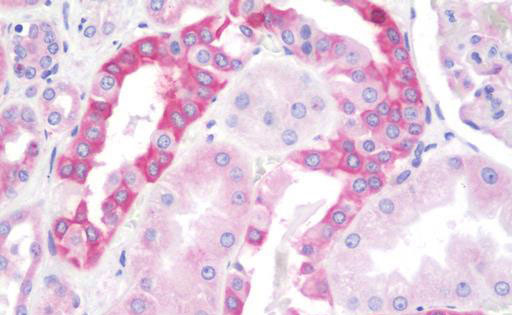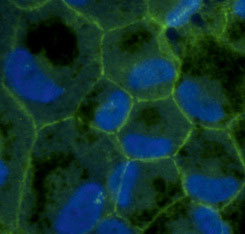TJP1 / ZO-1 Antibody (C-Terminus)
Goat Polyclonal Antibody
- SPECIFICATION
- CITATIONS
- PROTOCOLS
- BACKGROUND

Application
| WB, IHC-P, IF |
|---|---|
| Primary Accession | Q07157 |
| Reactivity | Human, Mouse, Rat, Monkey, Dog |
| Host | Goat |
| Clonality | Polyclonal |
| Calculated MW | 195kDa |
| Dilution | IF (1:50-1:250), IHC-P (10 µg/ml), WB (1:500-1:2000) |
| Gene ID | 7082 |
|---|---|
| Other Names | Tight junction protein ZO-1, Tight junction protein 1, Zona occludens protein 1, Zonula occludens protein 1, TJP1, ZO1 |
| Target/Specificity | Detects endogenous levels of total ZO-1 by Western blot in whole cell and tissue lysates. |
| Reconstitution & Storage | Store at 4°C short term. Aliquot and store at -20°C long term. Avoid freeze-thaw cycles. |
| Precautions | TJP1 / ZO-1 Antibody (C-Terminus) is for research use only and not for use in diagnostic or therapeutic procedures. |
| Name | TJP1 (HGNC:11827) |
|---|---|
| Function | TJP1, TJP2, and TJP3 are closely related scaffolding proteins that link tight junction (TJ) transmembrane proteins such as claudins, junctional adhesion molecules, and occludin to the actin cytoskeleton (PubMed:7798316, PubMed:9792688). Forms a multistranded TJP1/ZO1 condensate which elongates to form a tight junction belt, the belt is anchored at the apical cell membrane via interaction with PATJ (By similarity). The tight junction acts to limit movement of substances through the paracellular space and as a boundary between the compositionally distinct apical and basolateral plasma membrane domains of epithelial and endothelial cells. Necessary for lumenogenesis, and particularly efficient epithelial polarization and barrier formation (By similarity). Plays a role in the regulation of cell migration by targeting CDC42BPB to the leading edge of migrating cells (PubMed:21240187). Plays an important role in podosome formation and associated function, thus regulating cell adhesion and matrix remodeling (PubMed:20930113). With TJP2 and TJP3, participates in the junctional retention and stability of the transcription factor DBPA, but is not involved in its shuttling to the nucleus (By similarity). May play a role in mediating cell morphology changes during ameloblast differentiation via its role in tight junctions (By similarity). |
| Cellular Location | Cell membrane; Peripheral membrane protein; Cytoplasmic side. Cell junction, tight junction. Cell junction. Cell junction, gap junction. Cell projection, podosome. Note=Moves from the cytoplasm to the cell membrane concurrently with cell-cell contact (PubMed:7798316). Forms a condensed tight junction-linked belt of protein during junction formation which becomes anchored to the apical cell membrane via interaction with PATJ (By similarity). At podosomal sites, is predominantly localized in the ring structure surrounding the actin core (PubMed:20930113). Colocalizes with SPEF1 at sites of cell- cell contact in intestinal epithelial cells (PubMed:31473225) {ECO:0000250|UniProtKB:O97758, ECO:0000269|PubMed:20930113, ECO:0000269|PubMed:31473225, ECO:0000269|PubMed:7798316} |
| Tissue Location | The alpha-containing isoform is found in most epithelial cell junctions. The short isoform is found both in endothelial cells and the highly specialized epithelial junctions of renal glomeruli and Sertoli cells of the seminiferous tubules |
| Volume | 100 µl |

Thousands of laboratories across the world have published research that depended on the performance of antibodies from Abcepta to advance their research. Check out links to articles that cite our products in major peer-reviewed journals, organized by research category.
info@abcepta.com, and receive a free "I Love Antibodies" mug.
Provided below are standard protocols that you may find useful for product applications.
Background
The N-terminal may be involved in transducing a signal required for tight junction assembly, while the C-terminal may have specific properties of tight junctions. The alpha domain might be involved in stabilizing junctions. Plays a role in the regulation of cell migration by targeting CDC42BPB to the leading edge of migrating cells.
References
Willott E.,et al.Proc. Natl. Acad. Sci. U.S.A. 90:7834-7838(1993).
Ota T.,et al.Nat. Genet. 36:40-45(2004).
Zody M.C.,et al.Nature 440:671-675(2006).
Cohen C.J.,et al.Proc. Natl. Acad. Sci. U.S.A. 98:15191-15196(2001).
D'Atri F.,et al.J. Biol. Chem. 277:27757-27764(2002).
If you have used an Abcepta product and would like to share how it has performed, please click on the "Submit Review" button and provide the requested information. Our staff will examine and post your review and contact you if needed.
If you have any additional inquiries please email technical services at tech@abcepta.com.













 Foundational characteristics of cancer include proliferation, angiogenesis, migration, evasion of apoptosis, and cellular immortality. Find key markers for these cellular processes and antibodies to detect them.
Foundational characteristics of cancer include proliferation, angiogenesis, migration, evasion of apoptosis, and cellular immortality. Find key markers for these cellular processes and antibodies to detect them. The SUMOplot™ Analysis Program predicts and scores sumoylation sites in your protein. SUMOylation is a post-translational modification involved in various cellular processes, such as nuclear-cytosolic transport, transcriptional regulation, apoptosis, protein stability, response to stress, and progression through the cell cycle.
The SUMOplot™ Analysis Program predicts and scores sumoylation sites in your protein. SUMOylation is a post-translational modification involved in various cellular processes, such as nuclear-cytosolic transport, transcriptional regulation, apoptosis, protein stability, response to stress, and progression through the cell cycle. The Autophagy Receptor Motif Plotter predicts and scores autophagy receptor binding sites in your protein. Identifying proteins connected to this pathway is critical to understanding the role of autophagy in physiological as well as pathological processes such as development, differentiation, neurodegenerative diseases, stress, infection, and cancer.
The Autophagy Receptor Motif Plotter predicts and scores autophagy receptor binding sites in your protein. Identifying proteins connected to this pathway is critical to understanding the role of autophagy in physiological as well as pathological processes such as development, differentiation, neurodegenerative diseases, stress, infection, and cancer.



